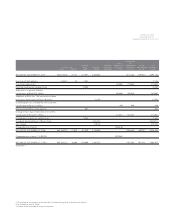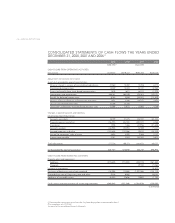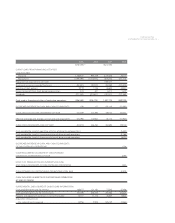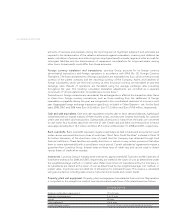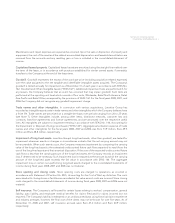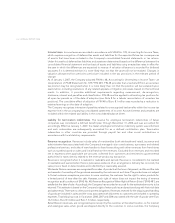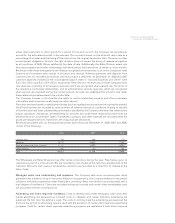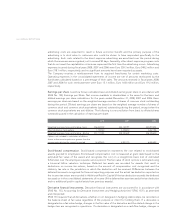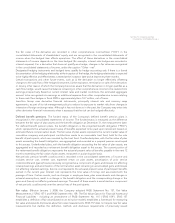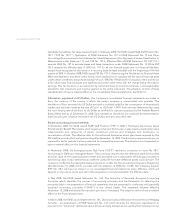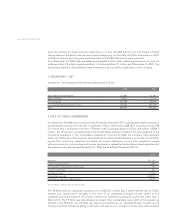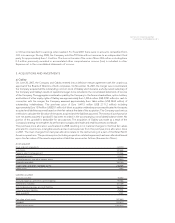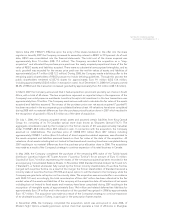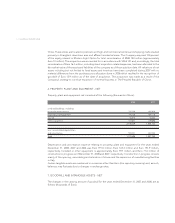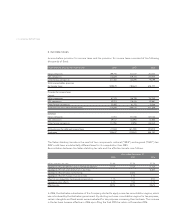LensCrafters 2008 Annual Report Download - page 67
Download and view the complete annual report
Please find page 67 of the 2008 LensCrafters annual report below. You can navigate through the pages in the report by either clicking on the pages listed below, or by using the keyword search tool below to find specific information within the annual report.
the fair value of the derivative are recorded in other comprehensive income/(loss) (“OCI”) in the
consolidated statements of shareholders’ equity and are recognized in the consolidated statements of
income when the hedged item affects operations. The effect of these derivatives in the consolidated
statements of income depends on the item hedged (for example, interest rate hedges are recorded in
interest expense). For a derivative that does not qualify as a hedge, changes in fair value are recognized
in the consolidated statements of income, under the caption “Other - net”.
Designated hedging instruments and hedged items qualify for hedge accounting only if there is a formal
documentation of the hedging relationship at the inception of the hedge, the hedging relationship is expected
to be highly effective and effectiveness is tested at the inception date and at least every three months.
Certain transactions and other future events, such as (i) the derivative no longer effectively offsetting
changes to the cash flow of the hedged instrument, (ii) the expiration, termination or sale of the derivative,
or (iii) any other reason of which the Company becomes aware that the derivative no longer qualifies as a
cash flow hedge, would cause the balance remaining in other comprehensive income to be realized into
earnings prospectively. Based on current interest rates and market conditions, the estimated aggregate
amount to be recognized into earnings as additional expense from other comprehensive income relating
to these cash flow hedges in fiscal 2009 is approximately Euro 14.7 million, net of taxes.
Luxottica Group uses derivative financial instruments, principally interest rate and currency swap
agreements, as part of its risk management policy to reduce its exposure to market risks from changes in
interest and foreign exchange rates. Although it has not done so in the past, the Company may enter into
other derivative financial instruments when it assesses that the risk can be hedged effectively.
Defined benefit pensions. The funded status of the Company’s defined benefit pension plans is
recognized in the consolidated statements of income. The funded status is measured as the difference
between the fair value of plan assets and the benefit obligation at December 31, the measurement date.
For defined benefit pension plans, the benefit obligation is the projected benefit obligation (“PBO”),
which represents the actuarial present value of benefits expected to be paid upon retirement based on
estimated future compensation levels. The fair value of plan assets represents the current market value of
cumulative company and participant contributions made to an irrevocable trust fund, held for the sole
benefit of participants, which are invested by the trust fund. Overfunded plans, with the fair value of plan
assets exceeding the benefit obligation, are aggregated and recorded as a prepaid pension asset equal
to this excess. Underfunded plans, with the benefit obligation exceeding the fair value of plan assets, are
aggregated and recorded as a retirement benefit obligation equal to this excess. The current portion of
the retirement benefit obligations represents the actuarial present value of benefits payable in the next 12
months exceeding the fair value of plan assets, measured on a plan-by-plan basis.
Net periodic pension benefit cost/(income) is recorded in the consolidated statements of income and
includes service cost, interest cost, expected return on plan assets, amortization of prior service
costs/(credits) and (gains)/losses previously recognized as a component of gains and (losses) not affecting
retained earnings and amortization of the net transition asset remaining in accumulated gains and (losses)
not affecting retained earnings. Service cost represents the actuarial present value of participant benefits
earned in the current year. Interest cost represents the time value of money cost associated with the
passage of time. Certain events, such as changes in employee base, plan amendments and changes in
actuarial assumptions, result in a change in the benefit obligation and the corresponding change in the
gains and (losses) not affecting retained earnings. The result of these events is amortized as a component
of net periodic cost/(income) over the service lives of the participants.
Fair value. Effective January 1, 2008, the Company adopted FASB Statement No. 157,
Fair Value
Measurements
, (“SFAS 157”) and FASB Statement No. 159,
The Fair Value Option for Financial Assets and
Financial Liabilities - Including an amendment of FASB Statement No. 115
(“SFAS 159”). SFAS 157
establishes a definition of fair value (based on an exit price model), establishes a framework for measuring
fair value and expands disclosures about fair value measurements. SFAS 157 does not require new fair value
measurements but clarifies the definition, method, and disclosure requirements of previously issued
NOTES TO CONSOLIDATED
FINANCIAL STATEMENTS |65 <


